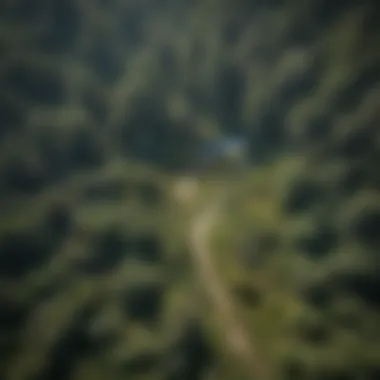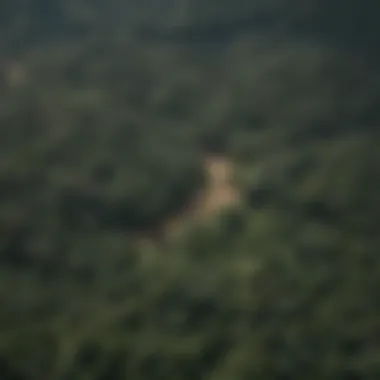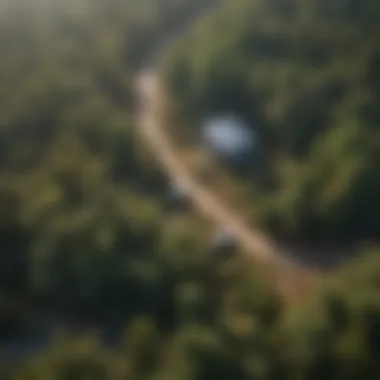Exploring Ikonos Satellite Imagery for Forestry


Intro
Ikonos satellite imagery has fundamentally changed the landscape of environmental monitoring and forestry management. As technological advancements continue to evolve, understanding the implications and applications of satellite imagery in these sectors becomes imperative. The use of high-resolution imagery not only enhances data for analysis but also enables informed decision-making in forestry practices. This section seeks to outline the critical themes that will be discussed throughout this article, providing a firm foundation for the in-depth exploration that follows.
Overview of Forestry Practices
Importance of Foresting
Forests are treasures of the Earth. They play a crucial role in maintaining ecological balance, supporting biodiversity, and providing resources such as timber and non-timber forest products. Healthy forests contribute to cleaner air and water, while also acting as significant carbon sinks to mitigate climate change. This underscores the importance of sustainable forestry practices, which aim to balance economic needs with environmental stewardship.
Types of Forestry Practices
Forestry practices can be classified into various categories based on objectives and methods. These include:
- Commercial forestry: Focuses on growing trees for profit. Emphasizes fast-growing species that can be harvested sustainably.
- Conservation forestry: Aimed at preserving ecosystems and habitats. Often involves selective logging and reduced-impact techniques to minimize disruptions.
- Agroforestry: Integrates trees with crops and livestock to diversify production and improve land use.
- Community forestry: Prioritizes the involvement of local communities in managing resources, fostering both ecological and socioeconomic benefits.
Best Practices for Sustainable Woodland Stewardship
Principles of Sustainable Forestry
Sustainable forestry hinges on several core principles:
- Ecological integrity: Maintaining the health of forest ecosystems is vital for long-term sustainability.
- Economic viability: Practices should support economic goals without compromising environmental health.
- Social equity: Successful management involves recognizing the needs of diverse stakeholders, including local communities.
Techniques for Land Management
Effective land management strategies are essential for achieving sustainable goals. Techniques may include:
- Selective logging: Minimizes impact by allowing certain trees to remain, fostering regeneration.
- Buffer zones: Establishing areas around water bodies to protect them from forestry activities.
- Controlled burns: Used to reduce the risk of wildfires while promoting healthy forest growth.
Innovative Techniques in Forestry
Latest Technological Advancements
Advances in technology have transformed forestry management. Ikonos satellite imagery exemplifies how remote sensing can improve data collection. High-resolution satellite images provide insights into forest health, growth rates, and land use changes. These insights are critical for effective planning and management.
Integrating Traditional Knowledge with Modern Science
Combining local knowledge with technological innovations leads to more effective forestry practices. Local communities bring valuable insights about ecosystems derived from generations of experience. When integrated with satellite data and scientific methodologies, this synergy can yield better outcomes.
"Combining modern science with traditional practices often leads to more effective solutions in forest management."
Understanding how to use these tools in concert not only enhances forest management strategies but also reaffirms the importance of community engagement in the stewardship of natural resources.
The discussions here lay the groundwork for a deeper examination of Ikonos satellite imagery. The subsequent sections will delve into various applications in detail, illustrating how this technology plays a vital role in promoting sustainable forestry and environmental management.
Prelude to Ikonos Satellite Imagery
The field of satellite imagery has revolutionized how we observe and manage our environment. Particularly, Ikonos satellite imagery stands out due to its high-resolution capabilities and breadth of applications in various sectors, most notably forestry management and environmental monitoring. This section provides a crucial overview of the Ikonos satellite and its significance in advancing land management practices.
Overview of Satellite Imaging Technology
Satellite imaging technology encapsulates a wide range of processes that transform satellite data into usable images. At its core, the technology enables the capture of the Earth’s surface by employing sensors onboard the satellite. These sensors measure electromagnetic radiation reflected or emitted from the Earth. The captured data is then processed to depict images that represent real-world objects and areas.
Ikonos, launched by GeoIQ in 1999, was one of the first commercial satellites to provide high-resolution imagery. With the ability to capture images at a resolution of 1 meter, it marked a significant advancement in satellite technology. The operational mechanism hinges on the interaction of light with the Earth’s surface materials, allowing for a detailed analysis of land cover, vegetation health, and urban development. The technology also utilizes various spectral bands, enhancing the capability to monitor changes over time and assess environmental conditions effectively.
Significance of High-Resolution Imagery
High-resolution imagery is paramount in forestry and environmental studies. The clarity and detail provided by high-resolution images enables forestry professionals to make informed decisions related to resource management and conservation strategies.
Some of the key benefits include:
- Enhanced Monitoring: Detailed views of forest structure and health improve monitoring efforts.
- Accurate Mapping: High-resolution images allow for precise mapping of land use changes and forest boundaries.
- Informed Policy-Making: Policymakers utilize high-resolution satellite images to develop better management strategies and conservation policies.
The significance of Ikonos imagery extends beyond forestry management. Its capabilities are crucial for disaster management, urban planning, and agricultural assessments. Understanding the detailed visual data provided by Ikonos is essential for any comprehensive environmental evaluation.
"The detailed spatial data provided by high-resolution satellite imagery can bridge the gap between observation and effective decision-making in resource management."


In summary, the introduction of Ikonos satellite imagery is not merely a technological feat but a pivotal component in the sustainable management of our natural resources.
The Ikonos Satellite: Features and Specifications
The exploration of Ikonos satellite imagery necessitates an understanding of its unique features and specifications. This section provides insight into the technical prowess of the Ikonos satellite and outlines its operational capabilities. By examining these elements, one can appreciate why Ikonos plays a pivotal role in environmental monitoring, especially in forestry management.
Technical Specifications
The Ikonos satellite, launched in September 1999, was a landmark in high-resolution Earth observation technology. Its ability to capture images with a resolution of up to 1 meter for panchromatic imagery and 4 meters for multispectral imaging set a new standard in satellite imaging.
Key specifications include:
- Weight: Approximately 800 kg
- Altitude: Operates at around 681 km above the Earth's surface
- Orbit Type: Sun-synchronous orbit, enabling consistent lighting conditions for image acquisition
- Sensor: The satellite features advanced sensors designed for capturing detailed surface information.
These specifications enable Ikonos to produce high-resolution images that are not only clear but rich in detail. Such characteristics are invaluable for applications in forestry management and environmental research.
Operational Capabilities
The operational capabilities of Ikonos extend beyond mere image acquisition. Its design facilitates various applications that significantly benefit forestry practices.
One notable capability is its revisit time. Ikonos can scan the same area repeatedly within a few days, allowing for timely updates on environmental changes. This is crucial for monitoring seasonal variations and assessing deforestation activities. Other operational features include:
- Multi-spectral and Panchromatic Imaging: The ability to capture different spectra increases the analysis potential for vegetation monitoring.
- Data Accessibility: The images captured are quickly processed and made available for various users, including environmental agencies and forestry experts.
- Flexible Data Distribution: Data can be used in multiple formats, making it easy for integration with existing mapping and analysis software.
Overall, the operational features of the Ikonos satellite enhance its relevance in various ecological studies. Its technological edge assures forestry professionals that they can rely on Ikonos for accurate and timely data, supporting effective management and policy-making initiatives in forestry.
"The Ikonos satellite provides insights that help connect the dots between policy and practice in forestry management, making it an essential resource for professionals in the field."
Data Acquisition Process
The Data Acquisition Process is a pivotal aspect when discussing Ikonos satellite imagery, as it encapsulates how information is gathered, processed, and made available for analysis. Understanding this process is essential for forestry professionals and academics who rely on satellite data for effective environmental monitoring and management.
Satellite Launch and Deployment
The journey of Ikonos begins with its launch into the Earth’s orbit. This satellite was deployed on September 24, 1999, from Vandenberg Air Force Base in California. The successful deployment marks the onset of acquiring high-resolution imagery.
Launching satellites involves intricate coordination among multiple teams. Key considerations include:
- Orbital Positioning: Ikonos operates in a sun-synchronous orbit, allowing it to capture images consistently under similar lighting conditions. This aspect is crucial for maintaining the quality and reliability of data.
- Payload Integration: The satellite is equipped with high-resolution imaging sensors capable of capturing images at a ground resolution of up to 1 meter. This specification is paramount for applications that require detail and precision.
The deployment phase also involves rigorous testing to ensure that all systems function optimally once in orbit. These tests are essential to confirm that the satellite can withstand the harsh environment of space and operate effectively throughout its mission lifespan.
Imagery Collection Techniques
Once operational, Ikonos employs various imagery collection techniques to gather data about the Earth’s surface. The most significant methods include:
- Multi-Spectral Imaging: Ikonos captures images in multiple wavelengths, allowing for a comprehensive analysis of different vegetation types and health assessments in forestry. This multi-spectral capability helps in distinguishing between plant species and understanding their conditions.
- Panoramic and Multi-View Imaging: The satellite can capture images from different angles, which assists in creating 3D representations of the terrain. This capability is particularly valuable for forestry management, as it helps visualize forest structures more accurately.
Moreover, timely data collection is facilitated through regular revisit times, which enables continuous monitoring of geographical changes. This frequent imaging is beneficial for tracking seasonal variations and significant land-use changes in forestry contexts.
Processing and Distribution of Data
The processing and distribution of data gathered by Ikonos is a final yet crucial step in the data acquisition process. This stage involves several vital actions:
- Image Processing: Raw data received from the satellite undergoes several procedures, such as radiometric and geometric corrections. This ensures that the imagery is accurate and usable for further analysis.
- Data Archiving: Processed images are then archived in databases, making them accessible for various applications, including environmental monitoring and land management.
- Data Distribution: The distribution of Ikonos imagery is facilitated through platforms that enable users to access and download the data in various formats. This step is essential for researchers who need to incorporate satellite imagery into their studies.
"The comprehensive processing and distribution network ensures that forestry professionals get the most relevant and accurate satellite imagery to inform their decisions."
Applications of Ikonos Satellite Imagery in Forestry
Ikonos satellite imagery plays a crucial role in forestry management. Its high-resolution images provide valuable insights necessary for effective conservation and land-use planning. By employing this technology, forest professionals can assess conditions in ways that were not possible with earlier methods. The following subsections explore the specific applications of Ikonos imagery in the forestry domain.
Forest Monitoring and Management
Monitoring forest health is essential for sustainable management. Ikonos imagery allows for detailed assessments of tree cover, species distribution, and overall forest conditions. This high-resolution data can detect changes over time, enabling forestry managers to identify areas impacted by disease or pests.
Benefits of using Ikonos imagery in forest monitoring include:


- Early detection of forest disturbances
- Assessment of recovery after adverse events
- Detailed reporting for stakeholders
By effectively utilizing these capabilities, one can enhance decision-making processes related to thinning operations or conservation strategies.
Land Use Change Detection
Changes in land use can threaten forest ecosystems. Ikonos imagery serves as a critical tool in detecting such shifts. It provides sufficient detail to identify urban encroachment and agricultural expansion into forested areas.
Key considerations in land use change detection include:
- Tracking illegal logging activities
- Observing trends in urbanization
- Analyzing reforestation efforts
Forest managers can develop strategies that mitigate negative impacts on forestry resources while promoting better land use practices based on this information.
Wildlife Habitat Assessment
Understanding wildlife habitats is a vital part of forest management. Ikonos imagery can assist in identifying habitats and assessing their conditions. This information can inform conservation efforts and support biodiversity initiatives.
Using satellite imagery for wildlife habitat assessment has several advantages, including:
- Mapping critical habitat areas
- Monitoring habitat fragmentation
- Gathering baseline data for research
"Effective wildlife management relies on precise data to sustain diverse ecosystems."
By integrating Ikonos imagery into habitat assessments, researchers and conservationists can ensure that necessary actions are taken to preserve and enhance wildlife populations.
Case Studies Using Ikonos Imagery
The integration of Ikonos satellite imagery into real-world applications demonstrates its immense values in forest management and ecological research. Case studies provide tangible examples of how high-resolution imagery can enhance decision-making processes, inform policy, and foster sustainable practices. They illustrate not only the operational capabilities of the Ikonos satellite but also its influence on conservation efforts and environmental assessments. In this section, we explore two significant case studies that highlight the practical applications of Ikonos satellite imagery in forestry contexts.
Forest Health Assessment in California
California's diverse ecosystems face numerous threats from climate change, pests, and disease. With vast areas of forest lands to monitor, assessing forest health becomes a complex task. Using Ikonos satellite imagery, researchers can conduct comprehensive analyses of forest health at a large scale. The high-resolution imagery offers near real-time data, allowing for timely interventions where necessary.
In a significant case study, scientists analyzed the imagery to detect early signs of tree stress related to drought conditions. They employed spectral analysis to identify changes in leaf reflectance, providing insights into tree vitality. This method allowed for identifying areas of severe stress before they became critically affected. The results prompted focused on-the-ground assessments for targeted management strategies.
Additionally, threats from invasive species can be monitored effectively with Ikonos imagery. By comparing historical and current images, researchers identified infestations and analyzed their spread over time. This information supports targeted control measures as well as public awareness campaigns about invasive species threats.
Ecosystem Restoration Projects in Brazil
Brazil's vast rainforests are vital for global biodiversity and climate regulation. Restoration projects in these areas aim to reverse deforestation and restore ecological balance. Ikonos satellite imagery plays a crucial role in these projects, providing detailed maps for planning and monitoring.
In a noteworthy project, the environmental agency used Ikonos images to identify deforested areas and prioritize restoration efforts. By analyzing land cover changes over time, planners could determine how effective previous restoration efforts were. This data not only informs reforestation initiatives but also helps stakeholders engage with local communities about land use impacts.
Moreover, the imagery facilitated monitoring of native species recovery during the restoration phase. The detailed imagery allows for the assessment of canopy cover and biodiversity improvements, thereby assessing whether desired outcomes are achieved. The use of Ikonos imagery thus enhances accountability and transparency in restoration initiatives, resulting in improved stakeholder trust.
The utilization of Ikonos satellite imagery in these case studies underscores its significant role in fostering sustainable forestry practices and informed ecological decision-making.
Through these case studies, we see how Ikonos satellite imagery directly influences forest health assessments and restoration efforts, showing its capability to drive data-informed strategies that lead to environmental sustainability.
Ecological Impact and Sustainable Practices
Importance of Ecological Impact and Sustainable Practices in Forestry
Ecological impact and sustainable practices are at the forefront of contemporary forestry management. Understanding how different techniques and technologies influence ecosystems is essential. Ikonos satellite imagery plays an integral role in grasping these influences. The high-resolution images provide data that help in monitoring changes within forests. This insight is vital for maintaining ecological balance and promoting sustainability.
Sustainable practices ensure that forest resources are utilized efficiently. They aim to minimize environmental degradation and foster biodiversity. Ikonos imagery helps map forest cover, identify tree species, and assess forest health. As a result, this technology supports decision-making processes that align with sustainable forestry goals.
Moreover, the use of remote sensing data facilitates awareness regarding the consequences of unsustainable activities. With clarity on forest dynamics, stakeholders can act responsibly. This includes avoiding overexploitation and managing land use effectively to support conservation efforts.
Enhancing Forest Stewardship
The enhancement of forest stewardship is crucial for sustainable management of forest resources. Ikonos satellite imagery contributes significantly in this regard. It enables foresters to visualize and analyze forest conditions in real-time. By employing high-resolution data, it becomes possible to monitor growth patterns, detect disease outbreaks, and assess the impact of various disturbances.
Foresters can also create detailed forest management plans based on accurate information. Specific tools, powered by Ikonos data, allow for distinguishing between healthy and distressed forest areas. Effective intervention strategies can then be developed to address identified problems. For instance, targeted reforestation efforts can be informed by spatial analysis of degraded regions.
Furthermore, engaging local communities in stewardship practices becomes easier. Visual data can stimulate discussions on sustainable management practices. By sharing imagery with stakeholders, a collective understanding of forest resources can be established.


Influence on Climate Policies
Climate change is a pressing global issue. The influence of Ikonos satellite imagery on climate policies cannot be overstated. Ecological assessments derived from satellite data help policymakers understand forest contributions to carbon sequestration and other environmental factors.
High-resolution imagery aids in quantifying biomass and forest cover changes. This information is crucial for creating informed climate strategies. Governments can better assess the effectiveness of current policies and adapt them based on emerging data. Moreover, the imagery supports reporting requirements under international agreements like the Paris Accord.
The data obtained from Ikonos can also guide investments in forestry practices that reduce emissions and promote climate resilience. For example, supporting sustainable harvesting methods can be prioritized when visual data confirms their effectiveness. In addition, it can help identify areas that need protection for maintaining biodiversity and enhancing ecosystem services.
Ultimately, the integration of satellite imagery fosters a comprehensive approach to climate policymaking. It ensures that decisions are based on precise, up-to-date data, aligning forestry management with broader environmental goals.
Challenges and Limitations of Ikonos Imagery
Understanding the challenges and limitations of Ikonos satellite imagery is crucial for forestry professionals and researchers. While the technology opens new avenues for environmental monitoring, it is essential to recognize potential drawbacks to optimize its use. Addressing these limitations can lead to improved data interpretation and better decision-making in forestry management.
Data Resolution Constraints
One of the primary limitations of Ikonos imagery is its data resolution. Ikonos provides high-resolution images at a spatial resolution of approximately 1 meter for panchromatic and 4 meters for multispectral bands. Although this allows for detailed observations, it also presents certain challenges:
- Limited Detail for Small Features: The resolution may not capture small-scale features or subtle variations in forest structure. For instance, identifying individual tree species or understory vegetation can be difficult.
- Variability in Light Conditions: Changes in light, such as shadows cast by taller trees, can affect image clarity and detail. This variability can lead to misinterpretations during analysis.
- Temporal Resolution: The revisit time of Ikonos could also restrict how often specific areas are monitored. High-frequency changes in forest health or land use may not be adequately captured.
Interoperability with Other Systems
Another critical issue is the interoperability of Ikonos imagery with other satellite systems and data sources. As forestry research often requires integrating data, the following factors are important:
- Data Format Compatibility: Ikonos imagery is typically in specific formats that may not align directly with other satellite data, necessitating data conversion and additional processing.
- Integration with GIS: While Ikonos data can be used in Geographic Information Systems (GIS), differences in projection or coordinate systems can complicate analyses.
- Collaboration with Other Imagery Feeds: Combining Ikonos data with other high-resolution sources, such as WorldView or Landsat, can pose challenges in standardizing methodologies for effective comparisons.
"The successful integration of satellite imagery requires not only advanced technology but also strategic planning to address existing limitations."
Future Prospects for Satellite Imagery in Forestry
The field of satellite imagery is evolving rapidly. For forestry management, this evolution presents numerous exciting opportunities. Both technological advancements and integration with advanced analytical methods hold significant promise for enhancing sustainable practices. Here, we explore how these developments may transform forestry management and environmental monitoring in the years to come.
Advancements in Satellite Technology
Recent advancements in satellite technology greatly expand the capabilities of forestry monitoring. New satellites are being equipped with advanced sensors that allow for higher resolutions and more accurate data collection. For instance, modern satellites can capture multispectral images, providing insights into various aspects of forest health.
These advancements enable better detection of tree species, assessment of tree health, and identification of stress factors such as drought or disease. Increased revisit frequency allows these satellites to collect data more often, which can provide dynamic changes in forest ecosystems over shorter time periods.
Moreover, miniaturization of satellite technology means that smaller and more cost-effective satellites can be launched. This leads to more diverse data acquisition systems available to researchers and forest managers. As a result, a greater range of data can be analyzed, contributing to a deeper understanding of forest dynamics.
Integration with AI and Big Data
The integration of artificial intelligence (AI) with satellite imagery is set to revolutionize forestry applications. AI algorithms can process vast amounts of data quickly and extract valuable insights that may not be apparent through traditional analysis methods.
Machine learning models can assist in identifying patterns related to tree growth, predicting fire risk, and even performing automated change detection. For example, by analyzing historical data, AI can forecast future forest conditions under various scenarios, thereby aiding in effective management strategies.
Big data analytics also plays a vital role in synthesizing information from various sources. By combining ground-based measurements with satellite data, forest managers can obtain a comprehensive view of the ecosystem. This multi-dimensional data approach allows for informed decision-making in policies related to conservation and resource management.
The collaboration between satellite technology, AI, and big data can lead to improved management of forest resources. It enhances predictive capabilities, ensuring that forest ecosystems are monitored effectively, and interventions are timely.
Ultimately, the fusion of satellite imagery, AI, and big data will deepen our understanding of forests, paving the way for smarter and more sustainable forestry practices.
In summary, the future of satellite imagery in forestry is promising. With ongoing advancements and integration of new technologies, the potential to enhance forest management strategies becomes increasingly feasible. Adopting these innovations can significantly contribute to achieving sustainable forestry goals and maintaining ecosystem balance.
End
The conclusion serves as a vital component of this article. It encapsulates the significance of Ikonos satellite imagery in addressing contemporary environmental and forestry challenges. This discussion lends weight to the importance of data-driven decision-making in sustainable forestry practices.
Summary of Insights Gained
Throughout this article, various points about the Ikonos satellite imagery have been underscored.
- The advancements in satellite technology enhance the capabilities of environmental monitoring.
- Applications in forestry, such as forest health, land use changes, and wildlife habitats, demonstrate practical benefits.
- Case studies presented reinforce the role of this imagery in real-world scenarios.
- Data resolution and interoperability challenges were acknowledged, highlighting areas for improvement.
These insights illustrate the critical role of Ikonos imagery in assessing ecosystem dynamics and formulating well-informed policies in forestry management.
Call to Action for Sustainable Practices
There's an urgent call for forestry professionals and policymakers to adopt sustainable practices utilizing Ikonos satellite imagery. By leveraging this technology, stakeholders can achieve effective forest monitoring and management.
- Engage with local communities to promote awareness about the benefits of satellite imaging.
- Integrate findings from Ikonos data into policy frameworks to enhance ecological stewardship.
- Explore future technological advancements for improved imagery and data handling.
Incorporating these practices is essential for achieving greater sustainability in forestry, ensuring that ecological balance is maintained for future generations.















